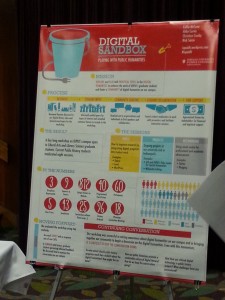Confessions of a novice tweeter
11 June 2014 – Dee Harris

Novice tweeter Dee Harris attached this photo to her first tweet from the 2014 NCPH conference in Monterey. Photo credit: Dee Harris
I’ve never considered myself a Luddite. I’ve had a smartphone for more than eight years, I occasionally post to Facebook, I’m signed up for a few blogs, and an e-reader has completely changed my reading habits. But when it comes to the fluttering noises of the little blue bird known as Twitter, the Luddite in me comes out. What useful information could actually come to me in the form of 140 characters or less? Do I have something to say that others want to read? I could never wrap my head around Twitter and why others found it so useful, so I just ignored it. At least I tried… but then came Jimmy Fallon and Justin Timberlake hashtagging on national television. Next, my 13-year-old son started adding verbal hashtags to everything he said. The final straw, however, was the National Council on Public History’s twitterstorm around the 2014 Monterey conference.
On my first day in Monterey, I quickly learned that the Twitter stream is an active and involved method of communication for many people involved in NCPH. You can’t be around people like Anne Whisnant, Denise Meringolo, and Mary Rizzo for long without recognizing the importance of Twitter as a channel of communication in our field. So I dutifully signed up. I downloaded the software, introduced myself to the twittersphere, followed the NCPH conference hashtag (#NCPH2014) and waited for the public history manna to fly in . . . and it did! That little blue bird just kept lighting up my smartphone with happenings around the conference, tidbits of conversation, and reminders for upcoming sessions and events that I wanted to attend. I cheerfully patted myself on the back for being so technologically adept and went on my merry way. But I soon learned that there can be much more to Twitter than just passively reading other people’s thoughts.
At the poster session, I chatted with Callie McCune about the brilliant design of the poster project she presented with fellow Indiana University-Purdue University Indianapolis (IUPUI) graduate students Nicholas Sacco, Christine Crosby, and Abby Curtin. When Callie asked me if I would tweet out my thoughts, I must admit that I was startled. I realized that I didn’t actually know “how” to tweet. Grudgingly, I admitted my ignorance and asked for help. Callie graciously showed me step-by-step how to make my first tweet and attach a picture (above). I felt a small measure of self-satisfaction with this success and spent the rest of the conference looking for tidbits of information that I could share while also gaining a few new followers.
Now, I can’t say that it was life-changing, but it was an eye-opening experience. As I’ve continued to use Twitter since the conference, I’m learning how it works best for me. Some of my follows include @NCPH, @USNatArchives, @ITweetMuseums, @PresNation, @NatlParkService, as well as the hashtag #publichistory. These are just some of the people and organizations in the twittersphere constantly tweeting updates on the public history field, including live tweeting from public history conferences and workshops.
Will Twitter ever become my virtual water cooler? Will you find me tweeting about all the latest happenings in my world? Probably not. But I have discovered its importance for the NCPH community in communicating important (and not-so-important) events, social and professional networking opportunities, and just plain interesting stuff.
For those of us with latent Luddite tendencies, navigating the social media world can be daunting. But entering the fray can also be quite rewarding. Each person using social media does it in different ways for different ends. So give it a try. Someone out there in the public history field wants to hear what you have to say.
~ Dee A. Harris is an exhibits specialist for the National Archives and Records Administration and a current member of the National Council on Public History Board of Directors.




For me, Twitter and Linkedin have become my “virtual watercooler”, even though I do not post much. I am a graduate student in an online program, thus I have limited interaction with others in my field. Social media has kept me abreast of many of the ongoing discussions in Public History, given me insight into the real world applications of the theories I am studying, and challenged some of my thinking.
I had both my graduate and undergraduate public history students follow #ncph2014 and report back to me in various ways. We followed up with classroom discussion about their findings. It was really interesting to me to see the themes they latched on to and the complaints/compliments they had about following the conference that way. I highly recommend it as a good assignment while we’re away at the conference.